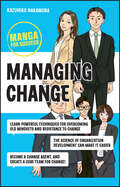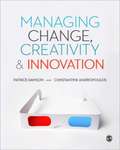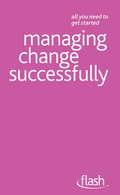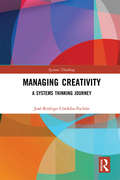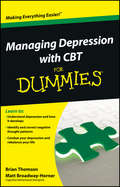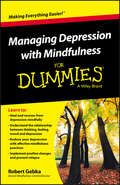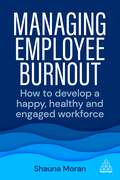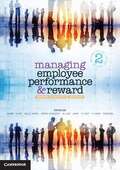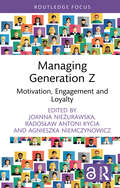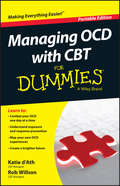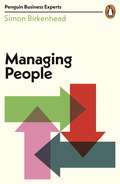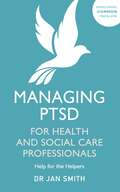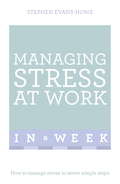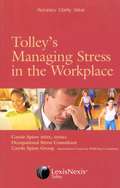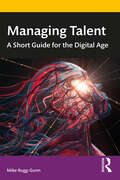- Table View
- List View
Managing Change: Manga for Success (Manga for Success)
by Kazuhiko NakamuraCREATE A HIGH-PERFORMING TEAM BY EMPLOYING EFFECTIVE CHANGE MANAGEMENT Do you want to improve your current workplace or organization? Organization Development can teach you what steps you can take to achieve your goals. You’ll follow Chuji, a store manager at an automobile company who’s been sent to a troubled dealership branch and learn from the challenges he faces as he implements a series of managerial changes only to meet resistance and hostility from employees and leaders. You’ll also learn about: How to overcome obstacles and resistance to organizational change How to employ the principles of visibility, communication, and visioning while leveraging the strengths of your team The science of organizational development Managing Change is an indispensable roadmap to effective change management that will help you shift the mindset of your team members from individualism to one focused on the good of the organization and the team as a whole. Find out why the Manga For Success series—now available in English for the first time—is so popular in Japan, Korea, and beyond.
Managing Change: Manga for Success (Manga for Success)
by Kazuhiko NakamuraCREATE A HIGH-PERFORMING TEAM BY EMPLOYING EFFECTIVE CHANGE MANAGEMENT Do you want to improve your current workplace or organization? Organization Development can teach you what steps you can take to achieve your goals. You’ll follow Chuji, a store manager at an automobile company who’s been sent to a troubled dealership branch and learn from the challenges he faces as he implements a series of managerial changes only to meet resistance and hostility from employees and leaders. You’ll also learn about: How to overcome obstacles and resistance to organizational change How to employ the principles of visibility, communication, and visioning while leveraging the strengths of your team The science of organizational development Managing Change is an indispensable roadmap to effective change management that will help you shift the mindset of your team members from individualism to one focused on the good of the organization and the team as a whole. Find out why the Manga For Success series—now available in English for the first time—is so popular in Japan, Korea, and beyond.
Managing Change, Creativity and Innovation (2nd edition) (PDF)
by Constantine Andriopoulos Patrick DawsonThis bestselling text continues to provide a fresh approach to organisational change by linking it to the key drivers of creativity and innovation, but now contains improved coverage of approaches to change. It explores change as a human and social process, looking at the vital role leadership, entrepreneurship and creativity play in change management, rather than viewing it as a series of systems and mechanisms. In doing so, it provides all the theoretical and practical understanding you will need as both a student of change and a future manager. The second edition comes with access to a range of learning and revision aids online and is packed with cases and examples from around the globe. Visit the companion website today at www. uk. sagepub. com/dawson. Lecturers/instructors - request a free digital inspection copy here
Managing Change Successfully: Managing Change Successfully (Flash)
by Bernice WalmsleyThe books in this bite-sized new series contain no complicated techniques or tricky materials, making them ideal for the busy, the time-pressured or the merely curious. In just 96 pages, Managing Change Successfully helps you to understand change and innovation; shows you how to introduce and manage change, deal with opposition and turn it in to a positive.
Managing Creativity: A Systems Thinking Journey (Systems Thinking)
by José-Rodrigo Córdoba-PachónFor over a century, creativity has unfolded as a valuable field of knowledge. Emerging from disciplines like psychology, management and education, the field of creativity is making strides in others including the arts and engineering. Research and education in this field helped it establish an identity as evidenced by a growing number of courses and specialised journals. However, this progress has come with a price. In a domain like management, institutionalisation of creativity in learning, research and practice has left creativity subordinated to concerns with standardisation, employability and economic growth. Values like personal fulfilment, uncertainty, improvement and connectedness which could characterise systemic views on creativity need to be rescued to promote more and inclusive dialogue between creativity stakeholders. The author aims to recover the importance of creativity as a systemic phenomenon and explores how applied systems thinking, or AST, can further support creativity. This demonstrates how creative efforts could be directed to improve quality of life for individuals as well as their environments. The book uses the systems idea as an enquiring device to bring together different actors to promote refl ection and action about creative possibilities. The chapters offer conceptualisations, applications and refl ections of systems ideas to help readers make sense of the field of creativity in academia and elsewhere. Complemented by the author’s own personal, conceptual and practical journey, the insights of the book will act as a vital toolkit for management researchers, career-driven students, practitioners and all creators to define and pursue creative ideas and thrive through their journeys to benefit themselves, other people and organisations.
Managing Creativity: A Systems Thinking Journey (Systems Thinking)
by José-Rodrigo Córdoba-PachónFor over a century, creativity has unfolded as a valuable field of knowledge. Emerging from disciplines like psychology, management and education, the field of creativity is making strides in others including the arts and engineering. Research and education in this field helped it establish an identity as evidenced by a growing number of courses and specialised journals. However, this progress has come with a price. In a domain like management, institutionalisation of creativity in learning, research and practice has left creativity subordinated to concerns with standardisation, employability and economic growth. Values like personal fulfilment, uncertainty, improvement and connectedness which could characterise systemic views on creativity need to be rescued to promote more and inclusive dialogue between creativity stakeholders. The author aims to recover the importance of creativity as a systemic phenomenon and explores how applied systems thinking, or AST, can further support creativity. This demonstrates how creative efforts could be directed to improve quality of life for individuals as well as their environments. The book uses the systems idea as an enquiring device to bring together different actors to promote refl ection and action about creative possibilities. The chapters offer conceptualisations, applications and refl ections of systems ideas to help readers make sense of the field of creativity in academia and elsewhere. Complemented by the author’s own personal, conceptual and practical journey, the insights of the book will act as a vital toolkit for management researchers, career-driven students, practitioners and all creators to define and pursue creative ideas and thrive through their journeys to benefit themselves, other people and organisations.
Managing Depression with CBT For Dummies
by Brian Thomson Matt Broadway-HornerRise above depression with CBT Cognitive Behavioural Therapy (CBT) is a hugely popular self-help technique, which teaches you to break free from destructive or negative behaviours and make positive changes to both your thoughts and your actions. This practical guide to managing depression with CBT will help you understand your depression, identify solutions to your problems, and maintain your gains and avoid relapse. Managing Depression with CBT For Dummies is a practical guide to using CBT to demolish depression by identifying and correcting negative thought patterns, recognizing the destructive power of ruminative thinking, confronting problems, and finding positive solutions. Helps you understand depression and how it develops Shows you how to correct negative thought patterns Gives you tried-and-true CBT techniques to combat your depression If you're struggling with depression, Managing Depression with CBT For Dummies gives you the tools you need to break down the barriers that prevent happiness from taking hold, and allowing you to build a positive future.
Managing Depression with CBT For Dummies
by Brian Thomson Matt Broadway-HornerRise above depression with CBT Cognitive Behavioural Therapy (CBT) is a hugely popular self-help technique, which teaches you to break free from destructive or negative behaviours and make positive changes to both your thoughts and your actions. This practical guide to managing depression with CBT will help you understand your depression, identify solutions to your problems, and maintain your gains and avoid relapse. Managing Depression with CBT For Dummies is a practical guide to using CBT to demolish depression by identifying and correcting negative thought patterns, recognizing the destructive power of ruminative thinking, confronting problems, and finding positive solutions. Helps you understand depression and how it develops Shows you how to correct negative thought patterns Gives you tried-and-true CBT techniques to combat your depression If you're struggling with depression, Managing Depression with CBT For Dummies gives you the tools you need to break down the barriers that prevent happiness from taking hold, and allowing you to build a positive future.
Managing Depression with Mindfulness For Dummies
by Robert GebkaRise above depression and build a positive future using mindfulnessIf you suffer from depression, you know that it′s not something you can simply snap yourself out of. Depression is a potentially debilitating condition that must be treated and managed with care, but not knowing where to turn for help can make an already difficult time feel even more harrowing. Thankfully, Managing Depression with Mindfulness For Dummies offers authoritative and sensitive guidance on using evidence based and NHS approved Mindfulness Based Interventions similar to Cognitive Behavioural Therapy (CBT) to help empower you to rise above depression and discover a renewed sense of emotional wellbeing and happiness. The book offers cutting edge self-management mindfulness techniques which will help you make sense of your condition and teach you how to relate differently to negative thought patterns which so often contribute to low mood and depression. The World Health Organization predicts that more people will be affected by depression than any other health problem by the year 2030. While the statistics are staggering, they offer a small glimmer of hope: you aren′t alone. As we continue to learn more about how depression works and how it can be treated, the practice of mindfulness proves to be an effective tool for alleviating stress, anxiety, depression, low self–esteem, and insomnia. With the tips and guidance offered inside, you′ll learn how to apply the practice of mindfulnessto ease your symptoms of depression and get your life back. Heal and recover from depression mindfully Understand the relationship between thinking, feeling, mood, and depression Reduce your depression with effective mindfulness practices Implement positive changes and prevent relapse Whether you are struggling with low mood or simply wish to learn mindfulness as a way of enriching your life, Managing Depression with Mindfulness For Dummies serves as a beacon of light and hope on your journey to rediscovering your sense of wellbeing, joy and happiness.
Managing Depression with Mindfulness For Dummies
by Robert GebkaRise above depression and build a positive future using mindfulnessIf you suffer from depression, you know that it′s not something you can simply snap yourself out of. Depression is a potentially debilitating condition that must be treated and managed with care, but not knowing where to turn for help can make an already difficult time feel even more harrowing. Thankfully, Managing Depression with Mindfulness For Dummies offers authoritative and sensitive guidance on using evidence based and NHS approved Mindfulness Based Interventions similar to Cognitive Behavioural Therapy (CBT) to help empower you to rise above depression and discover a renewed sense of emotional wellbeing and happiness. The book offers cutting edge self-management mindfulness techniques which will help you make sense of your condition and teach you how to relate differently to negative thought patterns which so often contribute to low mood and depression. The World Health Organization predicts that more people will be affected by depression than any other health problem by the year 2030. While the statistics are staggering, they offer a small glimmer of hope: you aren′t alone. As we continue to learn more about how depression works and how it can be treated, the practice of mindfulness proves to be an effective tool for alleviating stress, anxiety, depression, low self–esteem, and insomnia. With the tips and guidance offered inside, you′ll learn how to apply the practice of mindfulnessto ease your symptoms of depression and get your life back. Heal and recover from depression mindfully Understand the relationship between thinking, feeling, mood, and depression Reduce your depression with effective mindfulness practices Implement positive changes and prevent relapse Whether you are struggling with low mood or simply wish to learn mindfulness as a way of enriching your life, Managing Depression with Mindfulness For Dummies serves as a beacon of light and hope on your journey to rediscovering your sense of wellbeing, joy and happiness.
Managing Depression with Qigong
by Fran GaikMany people will suffer from depression at some time in their lives. New research shows that Qigong, a traditional Chinese practice, can be an effective treatment for depression and can provide a good alternative or supplement to medication in some cases. Frances Gaik explains the basics of what Qigong is and why it is effective for depression, and shows the reader how to make use of Qigong to rise from the darkness of depression and regain strength and motivation in life. Based on the same principles as Traditional Chinese Medicine, Qigong works by promoting the movement of health-giving energy along the meridians of the body. The author shows how the practical application of Qigong can radically improve health and wellbeing, and provides a treatment plan, including Qigong exercises. Encouraging the reader to identify their problems and take action, Dr. Frances Gaik gives practical advice that will help anyone with depression to improve their mental health. Managing Depression with Qigong provides a guide to an effective and increasingly recognised form of treatment that will be invaluable to people with depression and their families.
Managing Depression with Qigong (PDF)
by Fran GaikMany people will suffer from depression at some time in their lives. New research shows that Qigong, a traditional Chinese practice, can be an effective treatment for depression and can provide a good alternative or supplement to medication in some cases. Frances Gaik explains the basics of what Qigong is and why it is effective for depression, and shows the reader how to make use of Qigong to rise from the darkness of depression and regain strength and motivation in life. Based on the same principles as Traditional Chinese Medicine, Qigong works by promoting the movement of health-giving energy along the meridians of the body. The author shows how the practical application of Qigong can radically improve health and wellbeing, and provides a treatment plan, including Qigong exercises. Encouraging the reader to identify their problems and take action, Dr. Frances Gaik gives practical advice that will help anyone with depression to improve their mental health. Managing Depression with Qigong provides a guide to an effective and increasingly recognised form of treatment that will be invaluable to people with depression and their families.
Managing Employee Burnout: How to Develop A Happy, Healthy and Engaged Workforce
by Shauna MoranBurnout is a state of emotional, physical and mental exhaustion. In the workforce, it leads to higher levels of stress, greater sickness absence, sluggish productivity and increased staff turnover so addressing this is urgent.Managing Employee Burnout covers everything from what burnout is, what causes it and what different forms it can take. It also explores the role of the organization in employee burnout and includes specific guidance on how to manage burnout in remote and hybrid working environments and why dispersed teams may be more susceptible to burnout. Full of actionable advice and real world examples, this book demonstrates what strategies to put in place to safeguard staff retention and productivity from burnout as well as how to promote awareness and emotional intelligence in the business. This book also explains why effective company culture, communication, leadership and an inclusive talent strategy are key to building a healthy, engaged and sustainable workforce. There is also coverage of how to improve employees' mental health and discussion of the importance of taking a break and how to establish healthy boundaries. Managing Employee Burnout is crucial reading for all HR professionals and all those responsible for talent management who are looking to ensure a healthy, happy and productive workforce.
Managing Employee Performance And Reward: Concepts, Practices, Strategies
by John Shields Jack Robinson Michelle Brown Catherine Dolle-Samuel Robyn Johnson Sarah Kaine Peter McLean Andrea North-Samardzic Patrick O'Leary Geoff PlimmerNow in its second edition, Managing Employee Performance and Reward continues to offer comprehensive coverage of employee performance and reward, presenting the material in a conceptually integrated way. This new edition has been substantially updated and revised by a team of specialist contributors, and includes: • An increased focus on employee engagement and the alignment between the organisation's goals and the personal goals of employees • Expanded coverage of coaching, now a leading-edge performance enhancement practice • Extensive updates reflecting the major changes in employee benefits in recent years, as organisations strive to attract and retain talent • Updated coverage of executive salaries and incentives in the contemporary post-GFC environment. This popular text is an indispensable resource for both students and managers alike. Written for a global readership, the book will continue to have particular appeal to those studying and practising people management in the Asia-Pacific region.
Managing Generation Z: Motivation, Engagement and Loyalty (Routledge Open Business and Economics)
by Joanna Nieżurawska Radosław Antoni Kycia Agnieszka NiemczynowiczGeneration Z (Gen Z) is the young generation born between the mid-1990s and 2010s. They are now entering the market and starting their first jobs. Therefore, managers must shape the company workplace environment to encourage young employees to work efficiently and connect their future with the company. Only then will both managers and employees share mutual satisfaction from collaboration and aim at the common target, which should be the prosperity of the company. This book presents research results and techniques for analysing the working expectations and needs of Gen Z. The analyses were made in various countries in Europe: The Czech Republic, Latvia, Poland, and Portugal. The book contains chapters that present the analysis results and technical chapters that outline modern methods of analysis of management data, including tutorial chapters on machine learning, which currently makes a strong appearance in research in various disciplines. This volume will be of interest to researchers, academics, practitioners, and students in the fields of management studies, research methods, and human resource management.
Managing Generation Z: Motivation, Engagement and Loyalty (Routledge Open Business and Economics)
Generation Z (Gen Z) is the young generation born between the mid-1990s and 2010s. They are now entering the market and starting their first jobs. Therefore, managers must shape the company workplace environment to encourage young employees to work efficiently and connect their future with the company. Only then will both managers and employees share mutual satisfaction from collaboration and aim at the common target, which should be the prosperity of the company. This book presents research results and techniques for analysing the working expectations and needs of Gen Z. The analyses were made in various countries in Europe: The Czech Republic, Latvia, Poland, and Portugal. The book contains chapters that present the analysis results and technical chapters that outline modern methods of analysis of management data, including tutorial chapters on machine learning, which currently makes a strong appearance in research in various disciplines. This volume will be of interest to researchers, academics, practitioners, and students in the fields of management studies, research methods, and human resource management.
Managing OCD with CBT For Dummies
by Katie d'Ath Rob WillsonBreak the chains of OCD with Cognitive Behavioural Therapy Are you suffering from Obsessive Compulsive Disorder (OCD)? You're not alone. Whether you've tried countless treatments or are seeking help for the first time, this expert, accessible guide is your beacon of hope for breaking the chains of this crippling disorder. Managing OCD with CBT For Dummies uses mindfulness-based Cognitive Behavioural Therapy (CBT) to eradicate OCD from your day-to-day life. Through clear and sensitive direction, you'll find out how to identify and correct negative thought patterns, confront your problems with positive solutions and recognise the power of cognitive thinking. Once a term only used by psychologists and counselors, CBT is now in common use and has become the preferred treatment method for a variety of psychological issues, including anxiety and depression, self-esteem, eating disorders, addiction, and many others. If you're planning on trying it on its own or in conjunction with other types of therapies, you'll be heartened to know that a staggering 75% of people with OCD are significantly helped by CBT—which is why it remains the treatment of choice for tackling the disorder by the National Institute for Health and Clinical Excellence (NICE). Demonstrates how CBT encourages new thinking patterns to combat destructive thought tendencies Explains the causes and symptoms of OCD Shows you how to use CBT to modify everyday thoughts and behaviours with the aim of positively influencing your emotions Illustrates the importance of facing your fears and offers positive strategies on exposure therapy There's no need to let OCD continue to control your life. This how-to guide helps you break down the negative patterns that have been keeping you hostage—and allows you to build a positive future free of the hold of OCD.
Managing OCD with CBT For Dummies
by Katie d'Ath Rob WillsonBreak the chains of OCD with Cognitive Behavioural Therapy Are you suffering from Obsessive Compulsive Disorder (OCD)? You're not alone. Whether you've tried countless treatments or are seeking help for the first time, this expert, accessible guide is your beacon of hope for breaking the chains of this crippling disorder. Managing OCD with CBT For Dummies uses mindfulness-based Cognitive Behavioural Therapy (CBT) to eradicate OCD from your day-to-day life. Through clear and sensitive direction, you'll find out how to identify and correct negative thought patterns, confront your problems with positive solutions and recognise the power of cognitive thinking. Once a term only used by psychologists and counselors, CBT is now in common use and has become the preferred treatment method for a variety of psychological issues, including anxiety and depression, self-esteem, eating disorders, addiction, and many others. If you're planning on trying it on its own or in conjunction with other types of therapies, you'll be heartened to know that a staggering 75% of people with OCD are significantly helped by CBT—which is why it remains the treatment of choice for tackling the disorder by the National Institute for Health and Clinical Excellence (NICE). Demonstrates how CBT encourages new thinking patterns to combat destructive thought tendencies Explains the causes and symptoms of OCD Shows you how to use CBT to modify everyday thoughts and behaviours with the aim of positively influencing your emotions Illustrates the importance of facing your fears and offers positive strategies on exposure therapy There's no need to let OCD continue to control your life. This how-to guide helps you break down the negative patterns that have been keeping you hostage—and allows you to build a positive future free of the hold of OCD.
Managing People (Penguin Business Experts Series #11)
by Simon BirkenheadBecoming a manager is not a progression in your career, it's a move into an entirely new job, one that requires a unique set of skills. Get it right and you'll inspire your team to deliver outstanding results. But get it wrong and you'll create stress, apathy and dysfunction in your team.Penguin Business Expert Simon Birkenhead has been guiding first-time and established managers for over two decades, helping them implement his blueprint for success. Here he reveals his framework that clearly explains what you must do for your employees to be the best they possibly can. Learn how to:- Activate motivation - Set clear expectations - Provide effective feedback - Master your communication skills- Build a high-performance team cultureManaging People is your complete guide to becoming a truly great manager for whom people want to do their best work.
Managing PTSD for Health and Social Care Professionals: Help for the Helpers
by Dr Jan SmithSince early 2020, the already considerable stresses of working in health or social care have been greater than at any point in recent history. If you work in one of these fields, you may well be experiencing symptoms of trauma, burnout or compassion fatigue and wondering how you might move forward when you are balanced on the edge. This book is a 2-part guide to managing the symptoms of post-traumatic stress disorder (PTSD) if you are a health or social care professional. It takes a practical but holistic approach, with the intention of helping you develop a sense of self-awareness, a clear idea of your values and - critically - a strong support network.You will learn effective techniques for self-care, through practices like mindfulness and meditation; you will also come to understand more about the symptoms of trauma, moral injury and burnout - with insights on practising defensively and clear guidance for what the different treatments for PTSD are, and how to seek professional help. Small enough to keep to hand in a locker or desk drawer, and designed to be read in short pauses in breaks or at the end of a long shift, without being complicated or taxing, this accessible introduction throws a life raft to any medical or social care professional overwhelmed by a challenging and stressful working environment.
Managing Stress At Work In A Week: How To Manage Stress In Seven Simple Steps (In A Week)
by Stephen Evans-HoweSunday: Examine the common causes of stress from a work/organizational perspective and an individual levelMonday: Understand the basic psychological and physiological aspects of stressTuesday: Gain an overview of the issues of stress surrounding job roles and responsibility, and consider potential solutionsWednesday: Understand the stress associated with workload, work pressure and work environment and develop the tools to deal with itThursday: Create a supportive environment to combat conflict and certain behavioursFriday: Gain an insight into change management and how it can help relieve stress within your teamSaturday: Use practical steps to help individuals take responsibility for managing their own stress
Managing Stress In The Workplace (PDF)
by Carole SpiersWith one in five workers reported as having felt under extreme pressure at work, stress Is overtaking the common cold as the biggest cause of absence from work. Cases such as Walker v Northumberland County Council [1995] have put stress firmly on the workplace agenda. The HSE has established stress in the workplace as a health and safety issue that needs to be recognised and managed through the use of risk assessment. Management in all organisations is now under pressure to put preventative measures in placed and to establish effective management techniques in order to tackle work-related stress. Tolley's Managing Stress in the Workplace is a practical handbook that guides the manager through their responsibilities in this difficult area. It provides clear guidelines on stress management and prevention techniques and contains useful checklists, best practice recommendations, and case studies throughout, as well as HSE guidance. Tolley's Managing Stress in the Workplace addresses the key issues that organisations face today, including: * The nature of stress and its relationship to pressure * The legal and cost implications on the organisation * Identifying the current causes and effects * Bullying and violence at work * Post-traumatic stress after a critical incident * Stress and personal health issues * Individual stress management strategies * Developing and maintaining a robust organisation Being better able to effectively handle work-related stress makes for a healthier workforce, lower absenteeism, increased performance and lower staff turnover; all of which means that having the right systems in place could save your organisation substantial costs. Tolley's Managing Stress in the Workplace is a reference manual for managers, health and safety, personnel and occupational health advisors.
Managing Stress In The Workplace (PDF)
by Carole SpiersWith one in five workers reported as having felt under extreme pressure at work, stress Is overtaking the common cold as the biggest cause of absence from work. Cases such as Walker v Northumberland County Council [1995] have put stress firmly on the workplace agenda. The HSE has established stress in the workplace as a health and safety issue that needs to be recognised and managed through the use of risk assessment. Management in all organisations is now under pressure to put preventative measures in placed and to establish effective management techniques in order to tackle work-related stress. Tolley’s Managing Stress in the Workplace is a practical handbook that guides the manager through their responsibilities in this difficult area. It provides clear guidelines on stress management and prevention techniques and contains useful checklists, best practice recommendations, and case studies throughout, as well as HSE guidance. Tolley’s Managing Stress in the Workplace addresses the key issues that organisations face today, including: * The nature of stress and its relationship to pressure * The legal and cost implications on the organisation * Identifying the current causes and effects * Bullying and violence at work * Post-traumatic stress after a critical incident * Stress and personal health issues * Individual stress management strategies * Developing and maintaining a robust organisation Being better able to effectively handle work-related stress makes for a healthier workforce, lower absenteeism, increased performance and lower staff turnover – all of which means that having the right systems in place could save your organisation substantial costs. Tolley’s Managing Stress in the Workplace is a reference manual for managers, health and safety, personnel and occupational health advisors.
Managing Talent: A Short Guide for the Digital Age
by Mike Rugg-GunnRecruiting, selecting, retaining and developing great people are essential for any successful business. And the combination of digital transformation and post-pandemic work realities presents major challenges for all organisations. This book provides best practice talent management guidance for businesses undertaking digital transformation or facing digital disruption. Taking the reader through the stages of talent acquisition, selection, retention and development, this practical and concise book: sets out, assesses and predicts how the digital revolution impacts talent management practices, and helps the reader navigate the journey from an analogue to a digital organisation; updates talent management concepts and illustrates these with examples and cases of best practice across the business world; and enables senior leaders, talent management professionals and managers to quickly access and implement key learnings through the use of practitioner point summaries and a set of Ten Top Tips in each relevant chapter. The book provides practical insights, grounded in research, into how to manage talent in a fluid and dynamic world of digital change and is aimed at senior leaders and managers, and the HR community. It clearly shows how organisations undertaking a digital journey need to flex and adapt their talent management processes.
Managing Talent: A Short Guide for the Digital Age
by Mike Rugg-GunnRecruiting, selecting, retaining and developing great people are essential for any successful business. And the combination of digital transformation and post-pandemic work realities presents major challenges for all organisations. This book provides best practice talent management guidance for businesses undertaking digital transformation or facing digital disruption. Taking the reader through the stages of talent acquisition, selection, retention and development, this practical and concise book: sets out, assesses and predicts how the digital revolution impacts talent management practices, and helps the reader navigate the journey from an analogue to a digital organisation; updates talent management concepts and illustrates these with examples and cases of best practice across the business world; and enables senior leaders, talent management professionals and managers to quickly access and implement key learnings through the use of practitioner point summaries and a set of Ten Top Tips in each relevant chapter. The book provides practical insights, grounded in research, into how to manage talent in a fluid and dynamic world of digital change and is aimed at senior leaders and managers, and the HR community. It clearly shows how organisations undertaking a digital journey need to flex and adapt their talent management processes.
